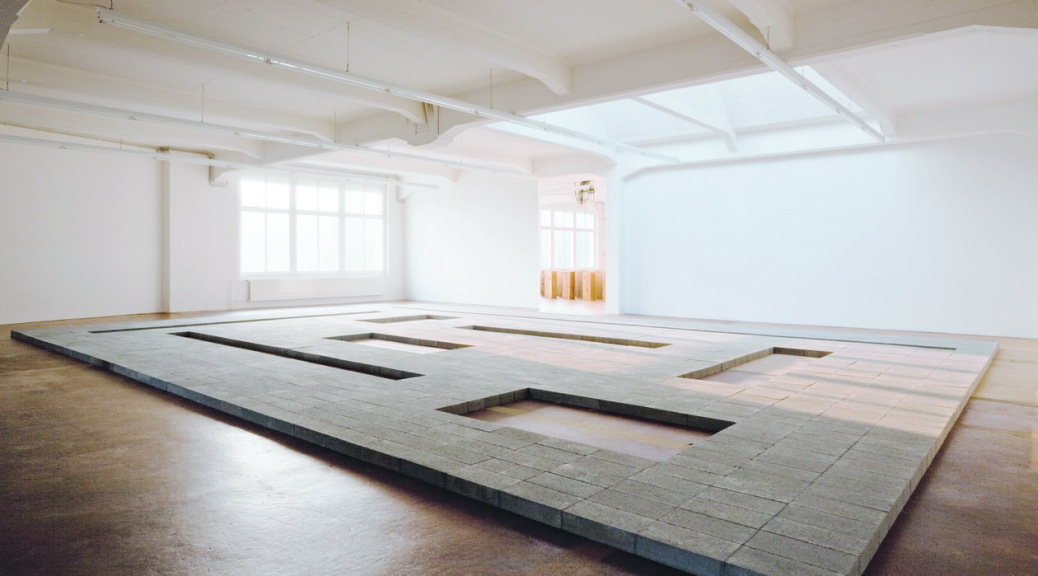Carl Andre
Cuts, 1967
„Cuts” ist ein Hauptwerk der Neuen Kunst. Nie zuvor hat ein Künstler eine Skulptur geschaffen, die mit vergleichbarer Konsequenz demokratische Grundprinzipien umsetzt und entsprechend auf die Wahrnehmung der Betrachter einwirkt. Es gibt keine hierarchischen Aspekte in diesem monumentalen Werk. Die Elemente, aus denen es besteht – Normbausteine aus Zement – sind gleich und gleichwertig und formen zusammen das Ganze. Sie besetzen dieselbe Ebene wie die Betrachter und fordern durch ihre Masse und horizontale Ausdehnung deren aktives Verhalten heraus. Jede Veränderung des Standpunkts eröffnet den Rezipienten neue Einsichten in die Vielseitigkeit einer scheinbar homogenen Gesamtheit.
„Cuts” besteht aus der seriellen Anordnung von 1232 Bausteinen, die sich zu einem kompakten Feld mit 8 „Einschnitten” verbinden. Die Grundfläche der Einschnitte ist gleich, ihre Form variiert zwischen einer Linie und einem fast quadratischen Rechteck. In jedem Fall sind 30 Steine ausgespart, doch die unterschiedliche Konstellation der Öffnungen erschwert die direkte Entschlüsselung des Prinzips.
Als zentrales Werk der Minimal Art findet sich „Cuts” in vielen Publikationen abgebildet. Aber zu erleben war das Werk lange nicht. Nach der legendären Ausstellung 1967 in der Dwan Gallery, Los Angeles, wurden die Steine wieder ihrer Funktion als Baumaterial zugeführt. Urs Raussmüller erwarb das Werk als Konzept vom Künstler, liess die Zementsteine in den Massen 4 x 8 x 16 Inch aus den USA nach Schaffhausen transportieren und errichtete „Cuts” (mit einem Gesamtgewicht von mehr als 16 Tonnen) im Mai 2000 in den Hallen für Neue Kunst, wo es bis 2014 zu sehen war.
In unserer Monografie “Cuts” (2011) finden Sie ausführliche Informationen und weitere aussagekräftige Bilder des Werkes.Carl Andre
Cuts, 1967
“Cuts” is one of the essential works of New Art. Never before had an artist created a sculpture that had applied fundamental democratic principles to such an extent and had such a corresponding effect on the observer. There are no hierarchical aspects in this powerful work. The elements it is made up of – standardized concrete capstones – are all the same, have the same value and create the whole in unison. They occupy the same level as the observer and, given their dimension and horizontal extension, demand the observer’s active approach. Every shift in viewpoint opens up new perspectives for the recipient onto multiple facets of this apparently homogenous whole.
“Cuts” is made up of a serial placement of 1232 rectangular stones that combine to form a compact field with eight “cuts”. The surface area of each cut is identical; their form aries between a line and an almost square rectangle. In each case 30 stones were omitted; however, the openings’ various constellations make it difficult to directly encrypt the principle.
As a central work of Minimal Art, illustrations of “Cuts” can be found in many publications. But the work could not be experienced for a long time. After the legendary exhibition in 1967 at the Dwan Gallery, Los Angeles, the stones then served their function as construction material. Urs Raussmüller purchased the concept from the artist, had the 4 x 8 x 16 inch concrete capstones imported from the USA to Schaffhausen and in May 2000 constructed “Cuts” (with a total weight of more than 16 tons) in the Hallen für Neue Kunst, where it could be experienced until 2014.
Find out more about this stunning artwork in our monograph “Cuts” (2011).
